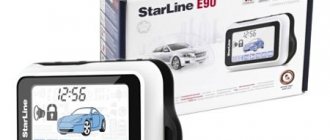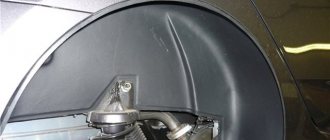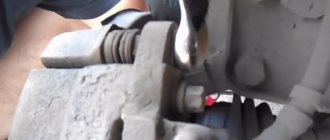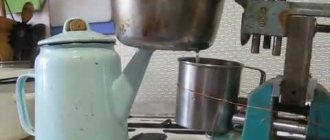Components and features
Cordon anticorrosive for protection against rust is produced in different volumes - cans of 1 and 2.3 kg, cans of 520 and 650 ml, and there are also Euro cans of 1000 ml.
This anticorrosive contains the following substances:
- Bitumen.
- Polymers.
- Rust inhibitors.
- Corrosion converters.
- Artificial rubber.
- Filler (fine dispersion).
- Plasticizer.
- Organic thinners.
Cordon is a material of high quality and efficiency that reliably protects the metal base from rust. It is needed to protect external parts, hidden areas of the car, as well as to protect the bottom and wheel arches.
After drying, a black coating is formed, similar to wax, does not allow moisture to pass through, and has good adhesion to various paints and varnishes.
They can be used to cover surfaces that have factory paints and varnishes. The substance has a high level of elasticity, vibration does not affect the coating, and tolerates different temperatures from -50 to +100.
Technical indicators of anticorrosive:
- Externally it is a black ointment.
- Consumption – up to 1 kg/sq.m.
- Clutch – 1 b.
- Dry fraction – up to 70%.
- Grinding – up to 100 microns.
- Strength before impact – 50 kgf/cm.
- Viscosity level – up to 150 s.
General information
Properties and composition of the product
The protective anti-corrosion agent “Cordon” is sold in different forms - these are tin cans of 1 kg and 2.3 kg, as well as aerosol cans of 0.52 and 0.65 liters, and also in European cans of 1 liter.
The anticorrosive composition is represented by the following components:
Bitumen.- Polymers.
- Rust converters.
- Synthetic rubber.
- Corrosion inhibitors.
- Plasticizers.
- Fine fillers.
- Organic types of solvents.
"Cordon" is a high-quality and effective material for protecting materials from corrosion. It is designed for processing external parts and hidden car cavities, as well as for noise protection of the underbody and wheel arches. As the composition dries, a black wax-like coating is formed, impermeable to moisture and has a high degree of adhesion to various paints and varnishes. The product can even be applied to factory paints and varnishes. It has an excellent degree of elasticity, will not deteriorate from vibration, and can also withstand temperature changes ranging from -50 to +100 degrees.
Technical characteristics of the product:
- Appearance: It is a pasty black mass.
- Product consumption ranges from 0.8 to 1 kg per square meter.
- Adhesion is 1 point.
- The proportion of dry residue ranges from 65 to 70%.
- The degree of grinding is from 70 to 100 microns.
- Impact strength is 50 kgf per cm.
- The conditional degree of viscosity ranges from 60 to 150 s (according to a special device VZ-246).
Now let's look at the advantages of the product.
Advantages of anticorrosive
“Cordon” will be highly effective against rust. It is resistant to water, makes the surface airtight, and therefore corrosion will stop developing. The product can be called thermally stable, because it easily tolerates both cold and heat up to + 100 degrees and can be used in any climate.
Please note that the product is universal and can be used to protect any metal products and structures from damage to the car body. Another product can be applied to wooden types of surfaces or used on other types of bases to protect against moisture and for noise insulation.
Bituminous anticorrosive agent "Cordon" is easily applied to surfaces that have not undergone preliminary preparation, and to parts that have been previously treated with this product. The composition will be ideally combined with paints and varnishes, and the degree of its adhesion will not decrease under any weather conditions. The waxy layer cannot be washed off even when using cleaning products.
Advantages of Cordon anticorrosive
Anticorrosive has good effectiveness in combating corrosion. It is not afraid of water, the base is sealed, because of this, rust cannot spread. The substance is also heat-resistant, not afraid of cold and heating up to +100, so it is suitable for any weather.
Anticorrosive is classified as a universal composition - it perfectly protects the car body and other metal objects.
In addition, it can be used to cover surfaces made of wood or other materials to protect against water and high noise.
Cordon can be used to cover bases that have not been prepared in any way or have already been covered with a similar substance.
Anticorrosive agent interacts well with paints and varnishes, with different protective and decorative layers, the level of adhesion is good in different weather conditions.
The wax-like layer cannot be removed even with the help of special substances.
Instructions for using “Cordon”
Before use, it is important to remove all grease, dirt, and remove parts of the old layer that falls off. It is also important to dry the surface thoroughly before coating.
If a metal container was purchased, then it is covered with a brush or roller.
If Cordon is very thick, then you can add solvent, gasoline, or white spirit to it. The best temperature for work is at least +15.
Tips for working with anticorrosive:
- It is important to dry the base well for about 6 hours, no less.
- There is no need to dry artificially because the mixture is highly flammable.
- It is necessary to apply the anticorrosive agent 2 or 3 times, after each application give about 1 hour for drying.
- After completion of the work, the coating is not touched for 24 hours, then you can use the car.
- During drying, there should be no drafts or different temperatures.
- If necessary, after complete drying, you can apply the coating again (this is often necessary if the layer thickness is less than 1 mm).
Before use, shake the can well for a couple of minutes, then spray it over the surface. The Euroballoon is also shaken and connected to the gun, the pressure should be up to 6 bar, applied at a distance of 30 cm. Cover 2-3 times, drying between layers for about an hour. During the procedure, smoking is prohibited; there should be no fire or heating devices nearby.
Work with anticorrosive only in personal protective equipment, on the street or where there is good air circulation, since anticorrosive releases toxins.
After completing the procedure, wash the instruments well with a solvent.
Remains of anticorrosive agent are stored in sealed packaging at a temperature of +10 – +50.
Coverage nuances
To dilute a substance, sometimes they do not use solvents, but simply heat the mixture.
To prevent it from catching fire, this is done using a water bath.
If there was a fire, wait until the top of the green tone burns out and everything is completed. If necessary, place a dampened rag on the layer to prevent oxygen from entering. This will not affect the quality of the product in any way, and the anticorrosive agent can then be used for its intended purpose.
Important tips when working with Cordon:
- After complete drying, you need to thoroughly inspect the base. Cracks may form due to temperature changes and the general environment during the procedure. To prevent this, buy a sealant for the car, cover the defects with it and wait 24 hours for it to dry.
- It is better not to use a spray gun for anticorrosion. Since there will be a lot of consumption with it, and the result may be a layer that is not the same in thickness.
- If the anticorrosive agent is thick, then you can work with it with a spatula - this option is possible. But, if the viscosity is very high, then it is better to heat it up a little.
- After complete drying, the coating turns out like glass melt with a specific shine. If the layer looks different, it means complete hardening has not yet occurred and you need to give it a little time to dry.
- To better protect against noise, you need to add a little bit of rubber crumbs to the anticorrosive. Most often, this option is made for external work.
- An organic thinner is suitable for removing Cordon; acetone or white spirit are excellent.
Automotive mastics
Is there a difference between ordinary bitumen rubber mastic and a similar composition for waterproofing the undersides and arches of cars? In principle, there is no difference. The only difference is the finely dispersed automotive grade technical rubber in the composition. Of course, in order to improve the quality of the material itself, manufacturers add plasticizers to it. With their help, they achieve improved quality in terms of impact resistance. It’s no secret that the bottom of a car and its arches are subject to impacts from stones flying out from under the wheels at high speed. Therefore, automotive mastic must withstand such loads when applied in a thin layer.
Anti-corrosion treatment for cars
Although the main purpose is anti-corrosion resistance. It should be noted that bitumen itself is already an excellent protection against metal corrosion. But manufacturers don't stop there. Today on the market you can buy more modern and high-quality rubber-bitumen mastics, to which various oils are added, especially of vegetable origin. They increase resistance to corrosion.
Plus, in addition to crumb rubber, aluminosilicates are also used as fillers. These additives increase sound insulation. Manufacturers today are trying to find the optimal ratio of components in order to increase the performance properties of rubber-bitumen mastic.
How to apply car mastic
First, some important tips. The pressure in the air gun should be 4-6 atm. The processing process itself is best carried out at a temperature of +20C, although manufacturers assure that even at +10C everything will work well.
Applying automotive mastic is no different from applying waterproofing:
- First, the bottom of the car must be washed with water and cleaned of dirt.
- Then use a spatula or any other tool to get rid of any areas of paint that have begun to peel off.
- Rust must be removed.
- Now you need to degrease the surface. To do this, you can use gasoline or white spirit.
- Places of severe corrosion should be refined with sandpaper or a wire brush.
- These rusty areas must be treated with a special compound - a rust converter.
- The jar is opened and the rubber mastic is mixed. If necessary, you can add a little solvent to it.
- The application process itself is carried out either manually using a roller or brush, or using a sprayer. In the second case, you need to put a mastic attachment on the air gun. In this case, the thickness of the applied layer should be 1.2-2.0 mm. This size will shrink as it dries.
Rubber bitumen mastic is an excellent waterproofing material. With its help, you can protect most surfaces, including the underbody and arches of the car, from penetration and exposure to moisture.
Like?
Use in construction and other fields
This anticorrosive agent is designed to protect the car body from corrosion, but it is also used in other areas:
- Obtaining hydrophobic layers on structures made of metal, wood, concrete, even those that work in buried soil (layer up to 1 mm).
- To protect concrete supports, walls, and foundations that are constantly exposed to moisture (up to 0.7 mm).
- To create protection against rust on pipelines and various metal products (up to 1.5 mm).
- Overlapping of old materials on the roof (as simple painting, layer no more than 0.3 mm).
- Sealing joints and seams on different surfaces.
- Like priming surfaces of concrete, brick, various materials before finishing, laying parquet, slabs on the floor, laying an insulation system (the substance is diluted to the thickness of simple paint).
Often “Cordon” is purchased to cover garages, stairs, various structures, fences, so that moisture does not appear on them and does not begin destructive processes.
“Cordon” protects wood that has begun to rot and is often used for soft roofing.
This composition is in great demand in industry, in car repairs, and in everyday life, because it has a universal composition, is easy to work with, and gives good results.
Features of use
Before applying a rubber-bitumen coating, any surface must be in a dry state, thoroughly cleaned of large and small debris, and poorly adhering pieces of old finish. On metal structures, areas with rust need to be cleaned, sand and dust must be removed from concrete surfaces, and mineral porous surfaces need to be pre-treated with primer. As a rule, a company that produces mastics also produces primers that are perfectly combined with rubber-bitumen compounds.
Not only the surface of the structure and structure needs preparatory measures, but also the rubber-bitumen composition itself. Cold-curing mastic, packaged in jars, is a finished product; before use, it is simply mixed thoroughly.
There are mixtures that are applied to the surface only using a hot method, for which the mastic is heated to a certain temperature. Depending on the temperature at which the composition softens, mastics are divided into brands. For the MBR-65 brand, softening of the composition occurs if it is heated to +65 C, for the MBR-75 brand - to +75 C, and in order to soften the MBR-90 brand mastic, you will have to heat it to +90 C. To carry out direct work, the composition is heated to 160-180? C.
There are instructions according to which the composition should be applied in layers. If the surface area is small, then you can use a brush, roller, or brush. For hard-to-reach places where you need to apply a very thin layer of the compound, an aerosol is the best option.
The number of layers depends on the type of work. For gluing materials, one layer is enough, and if the composition is used as an insulating coating, then it will have to be applied two, and in some cases, three times. After applying each layer, drying time is required; at an air temperature of +20 C, complete hardening of the coating occurs no earlier than after 24 hours.
When working with mastic, you should take all precautions. This will help not only avoid injuries, but also get the highest quality results.
For more information on how to work with rubber-bitumen mastic, see the following video.










